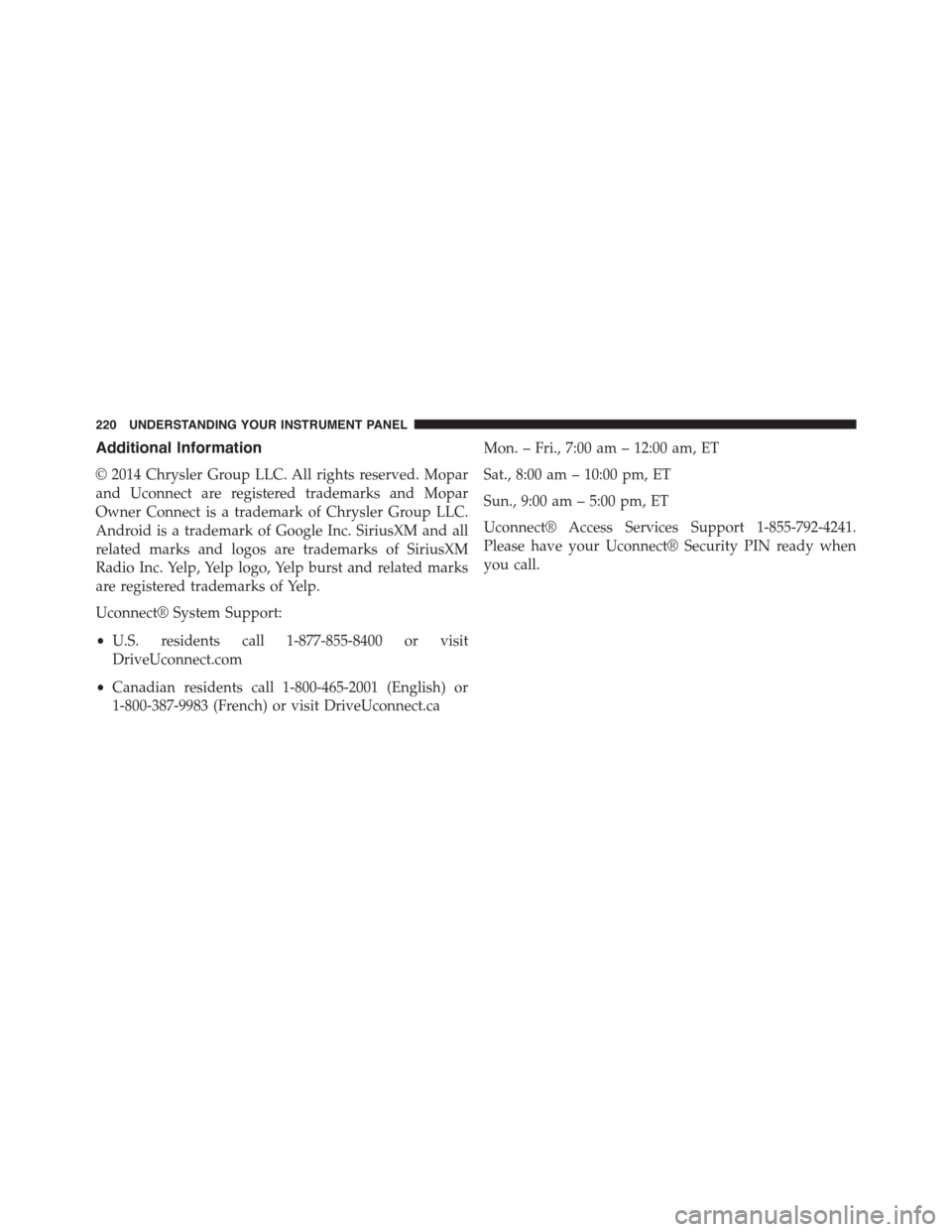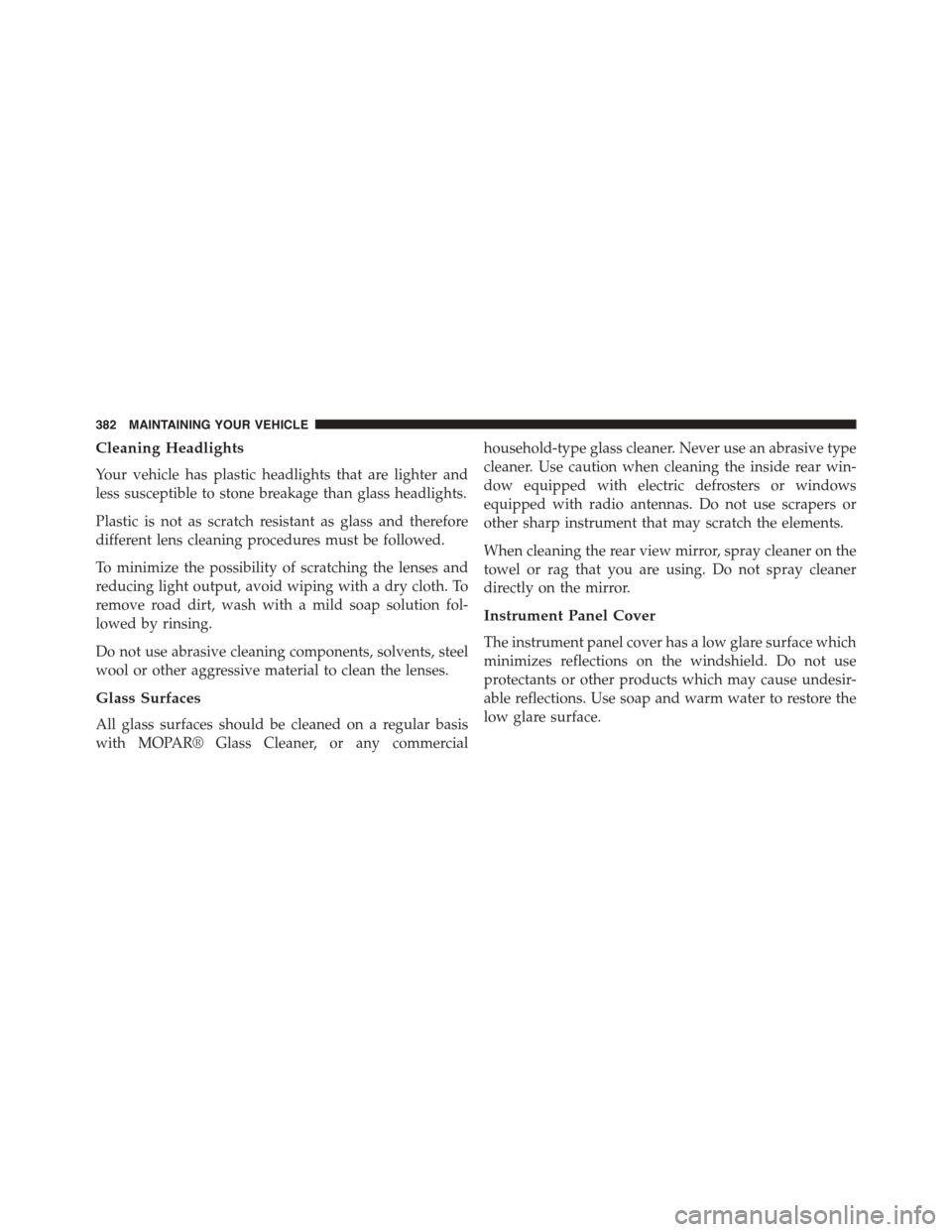2015 FIAT 500L radio
[x] Cancel search: radioPage 222 of 438

Additional Information
© 2014 Chrysler Group LLC. All rights reserved. Mopar
and Uconnect are registered trademarks and Mopar
Owner Connect is a trademark of Chrysler Group LLC.
Android is a trademark of Google Inc. SiriusXM and all
related marks and logos are trademarks of SiriusXM
Radio Inc. Yelp, Yelp logo, Yelp burst and related marks
are registered trademarks of Yelp.
Uconnect® System Support:
•U.S. residents call 1-877-855-8400 or visit
DriveUconnect.com
•Canadian residents call 1-800-465-2001 (English) or
1-800-387-9983 (French) or visit DriveUconnect.ca
Mon. – Fri., 7:00 am – 12:00 am, ET
Sat., 8:00 am – 10:00 pm, ET
Sun., 9:00 am – 5:00 pm, ET
Uconnect® Access Services Support 1-855-792-4241.
Please have your Uconnect® Security PIN ready when
you call.
220 UNDERSTANDING YOUR INSTRUMENT PANEL
Page 299 of 438

text message will display when one or more of the four
active road tire pressures are low. Should this occur, you
should stop as soon as possible, check the inflation
pressure of each tire on your vehicle, and inflate each tire
to the vehicle’s recommended cold placard pressure
value. The system will automatically update and the Tire
Pressure Monitoring Light will extinguish once the up-
dated tire pressures have been received. The vehicle may
need to be driven for up to 20 minutes above 15 mph
(24 km/h) to receive this information.
Check TPMS Warnings
The Tire Pressure Monitoring Telltale Light will flash on
and off for 75 seconds and remain on solid when a system
fault is detected, an audible chime will be activated and
the “Service Tire Pressure Monitoring System” text mes-
sage will display. If the ignition key is cycled, this
sequence will repeat providing the system fault still
exists. The Tire Pressure Monitoring Telltale Light will
turn off when the fault condition no longer exists. A
system fault can occur with any of the following sce-
narios:
1. Jamming due to electronic devices or driving next to
facilities emitting the same radio frequencies as the
TPM sensors.
2. Installing some form of aftermarket window tinting
that affects radio wave signals.
3. Snow or ice around the wheels or wheel housings.
4. Using tire chains on the vehicle.
5. Using wheels/tires not equipped with TPM sensors.
NOTE:Your vehicle may be equipped with a compact
spare wheel and tire assembly.
1. The compact spare tire does not have a tire pressure
monitoring sensor. Therefore, the TPMS will not moni-
tor the tire pressure in the compact spare tire.
5
STARTING AND OPERATING 297
Page 313 of 438

HAZARD WARNING FLASHERS
The Hazard Warning flasher switch is located on the
instrument panel below the radio.
Press the switch to turn on the Hazard Warning
flashers. When the switch is activated, all direc-
tional turn signals will flash on and off to warn oncoming
traffic of an emergency. Press the switch a second time to
turn off the Hazard Warning flashers.
Do not use this emergency warning system when the
vehicle is in motion. Use it when your vehicle is disabled
and it is creating a safety hazard for other motorists.
If it is necessary to leave the vehicle to go for service, the
Hazard Warning flashers will continue to operate with
the ignition key removed and the vehicle locked.
NOTE:With extended use, the Hazard Warning flashers
may wear down your battery.
IF YOUR ENGINE OVERHEATS
In any of the following situations, you can reduce the
potential for overheating by taking the appropriate ac-
tion.
•On the highways — slow down.
•In city traffic — while stopped, place the transmission
in NEUTRAL, but do not increase engine idle speed.
NOTE:There are steps that you can take to slow down
an impending overheat condition:
•If your air conditioner (A/C) is on, turn it off. The A/C
system adds heat to the engine cooling system and
turning the A/C off can help remove this heat.
•You can also turn the temperature control to maximum
heat, the mode control to floor and the blower control
to high. This allows the heater core to act as a
supplement to the radiator and aids in removing heat
from the engine cooling system.
6
WHAT TO DO IN EMERGENCIES 311
Page 336 of 438

WARNING!
•Take care to avoid the radiator cooling fan when-
ever the hood is raised. It can start anytime the
ignition switch is ON. You can be injured by
moving fan blades.
•Remove any metal jewelry such as rings, watch
bands and bracelets that could make an inadvertent
electrical contact. You could be seriously injured.
•Batteries contain sulfuric acid that can burn your
skin or eyes and generate hydrogen gas which is
flammable and explosive. Keep open flames or
sparks away from the battery.
1. Set the parking brake, shift the Euro Twin Clutch
Transmission into PARK and turn the ignition to OFF.
2. Turn off the heater, radio, and all unnecessary electri-
cal accessories.
3. Remove the protective cover over the remote positive
(+)battery post. To remove the cover, pull upward on
the cover.
4. If using another vehicle to jump-start the battery, park
the vehicle within the jumper cables reach, set the
parking brake and make sure the ignition is OFF.
WARNING!
Do not allow vehicles to touch each other as this
could establish a ground connection and personal
injury could result.
334 WHAT TO DO IN EMERGENCIES
Page 384 of 438

Cleaning Headlights
Your vehicle has plastic headlights that are lighter and
less susceptible to stone breakage than glass headlights.
Plastic is not as scratch resistant as glass and therefore
different lens cleaning procedures must be followed.
To minimize the possibility of scratching the lenses and
reducing light output, avoid wiping with a dry cloth. To
remove road dirt, wash with a mild soap solution fol-
lowed by rinsing.
Do not use abrasive cleaning components, solvents, steel
wool or other aggressive material to clean the lenses.
Glass Surfaces
All glass surfaces should be cleaned on a regular basis
with MOPAR® Glass Cleaner, or any commercial
household-type glass cleaner. Never use an abrasive type
cleaner. Use caution when cleaning the inside rear win-
dow equipped with electric defrosters or windows
equipped with radio antennas. Do not use scrapers or
other sharp instrument that may scratch the elements.
When cleaning the rear view mirror, spray cleaner on the
towel or rag that you are using. Do not spray cleaner
directly on the mirror.
Instrument Panel Cover
The instrument panel cover has a low glare surface which
minimizes reflections on the windshield. Do not use
protectants or other products which may cause undesir-
able reflections. Use soap and warm water to restore the
low glare surface.
382 MAINTAINING YOUR VEHICLE
Page 422 of 438

Adding Engine Coolant (Antifreeze)............367
Adding Fuel.............................302
Adding Washer Fluid......................362
Additives, Fuel...........................300
Air bag . . . . . . . . . . . . . . . . . . . . . . . . . . . . . . . . .44
Air Bag
Air bag Operation.......................47
Air Bag Warning Light....................57
Driver Knee Air Bag......................48
Enhanced Accident Response................55
Event Data Recorder (EDR).................60
Front Air Bag . . . . . . . . . . . . . . . . . . . . . . . . . . .44
If A Deployment Occurs...................53
Knee Impact Bolsters.....................48
Maintaining Your Air Bag System............59
Air bag Deployment........................44
Air bag Light.............................57
Air bag Maintenance........................59
Air Cleaner, Engine (Engine Air Cleaner Filter) . . . .352
Air Conditioner Maintenance.................355
Air Conditioning Filter.....................356
Air Conditioning Refrigerant.................355
Air Conditioning System....................355
Air Pressure, Tires.........................279
Alarm (Security Alarm)......................15
Alarm System (Security Alarm)................15
Alfa Twin Clutch Transmission
Fluid Type............................374
Alterations/Modifications, Vehicle...............8
Antifreeze (Engine Coolant)..................366
Capacities............................397
Disposal..............................369
Anti-Lock Brake System (ABS)................257
Anti-Lock Warning Light....................177
Appearance Care.........................377
Arming System (Security Alarm)...............15
Audio Systems (Radio).....................187
Automatic Dimming Mirror...................93
420 INDEX
Page 432 of 438

Pretensioners
Seat Belts..............................40
Radial Ply Tires..........................281
Radio Operation..........................190
Rear Camera............................134
Rear Liftgate (Sedan).......................29
Rear Window Features.....................160
Reclining Rear Seats.......................103
Recorder, Event Data.......................60
Recreational Towing.......................306
Reformulated Gasoline.....................299
Refrigerant..............................355
Reminder, Seat Belt.........................33
Remote Keyless Entry (RKE)
FCC General Information..................21
Remote Sound System (Radio) Controls.........188
Replacement Bulbs........................390
Replacement Keys.........................15
Replacement Parts.........................348
Replacement Tires.........................289
Reporting Safety Defects....................413
Restraints, Child...........................61
Restraints, Occupant........................31
Rotation, Tires...........................292
Safety Checks Inside Vehicle..................85
Safety Checks Outside Vehicle.................87
Safety Defects, Reporting....................413
Safety, Exhaust Gas.........................84
Safety Information, Tire.....................266
Safety Tips...............................83
Schedule, Maintenance.....................402
Seat Belt
Disengage The Automatic Locking Mode.......43
Engage The Automatic Locking Mode.........43
Lap/Shoulder Belts.......................34
Lap/Shoulder Belt Untwisting...............39
430 INDEX
Page 437 of 438

INSTALLATION OF RADIO TRANSMITTING
EQUIPMENT
Special design considerations are incorporated into this
vehicle’s electronic system to provide immunity to radio
frequency signals. Mobile two-way radios and telephone
equipment must be installed properly by trained person-
nel. The following must be observed during installation.
The positive power connection should be made directly
to the battery and fused as close to the battery as possible.
The negative power connection should be made to body
sheet metal adjacent to the negative battery connection.
This connection should not be fused.
Antennas for two-way radios should be mounted on the
roof or the rear area of the vehicle. Care should be used
in mounting antennas with magnet bases. Magnets may
affect the accuracy or operation of the compass on
vehicles so equipped.
The antenna cable should be as short as practical and
routed away from the vehicle wiring when possible. Use
only fully shielded coaxial cable.
Carefully match the antenna and cable to the radio to
ensure a low Standing Wave Ratio (SWR).
Mobile radio equipment with output power greater than
normal may require special precautions.
All installations should be checked for possible interfer-
ence between the communications equipment and the
vehicle’s electronic systems.